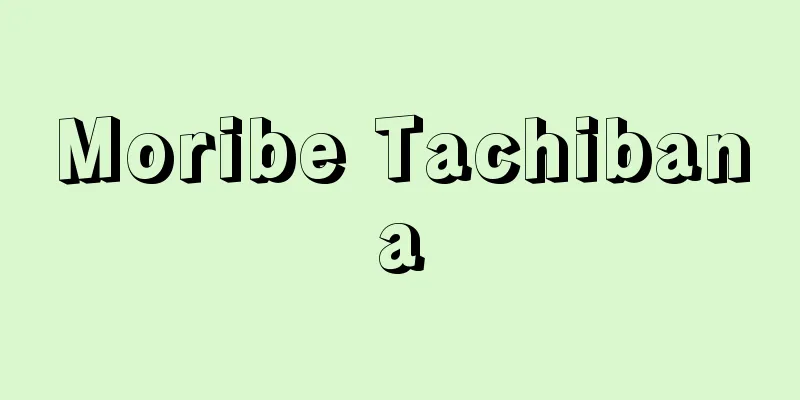Moribe Tachibana

|
A Japanese scholar in the late Edo period. His real surname was Iida. He took the surnames Kitabatake and Minamoto on his father's side, and Tachibana on his mother's side, which were his ancestors. His childhood name was Asahiya, later Yoshiya. His given name was Niwamaro. He was commonly known as Motosuke and Gensuke. His pen names were Houko, Ikugusurizono, Chian, and Shiimoto. He was born on April 8, 1st year of Tenmei, in Obuke village, Asake county, Ise province (Asahi town, Mie prefecture) as the eldest son of his father, Chojuro Motochika, a disciple of Tanikawa Kotosuga, a local samurai, and his mother, the younger sister of Kusunoki Moritada, a local samurai in Kuwana county. At the age of two, his mother divorced him, at the age of twelve his family broke up, at the age of sixteen his father died of illness, and the following year in 1797 he went to Edo, where he studied Chinese classics under Kasai Inze (1764-1823), and at the age of twenty-nine he became a kyoka poet in Satte, Musashi Province (Satte City, Saitama Prefecture), and gained disciples from textile manufacturers in Kiryu and Ashikaga. From the age of forty-nine he lived in Edo's Fukagawa Oshima-cho and Asakusa Bentenyama, and died of illness at his home in Nihonsho on May 24, 1859. He was 69 years old. His grave is at Ushijima Chomei-ji Temple (Mukojima, Sumida Ward, Tokyo). He was friends with Shimizu Hamaomi and Yasuda Mitsuru (1763-1816), but he was self-taught and criticized Motoori Norinaga, establishing his own academic style. Along with Ban Nobutomo, Hirata Atsutane, and Kagawa Kageki, he was known as one of the four great masters of the Tenpo period. He highly valued the "Nihon Shoki" and wrote its commentary "Itsunochiwaki" (completed in 1844) and commentaries on the songs of the Kojiki and Nihon Shoki "Kotowaki" (1850, 1891-1894). He also wrote "Manyoshu Hinotsuma-de", "Manyoshu Suminawa", "Kagurauta Fuiriaya", and "Saiuma Music Score". He wrote new interpretations in "Barafu Nyubun" (1834), and expressed his original views on waka rhetoric in "Tanka Senkaku" (1885) and "Choka Senkaku". He also wrote language books such as "Jouji Hongi Ichiran" (1838), "Zokugo Ko", "Yamabiko Zoshi" (1831), and "Kane no Hibiki" (Bell's Echoes), which are packed with examples, but also show dogmatic opinions based on sound and meaning and intuition. His more than 4,400 poems are gentle and elegant, and are in the style of ancient and modern poetry, and are collected in "Tachibana Moribe Kashu" (1854). [Tsutomu Hayashi June 20, 2016] "Complete Works of Tachibana Moribe, edited by Tachibana Junichi, 13 volumes (1920-1922, Kokusho Kankokai/Revised and expanded, 14 volumes, 1967, Tokyo Bijutsu)" ▽ "Kokugaku Taikei 14, Tachibana Moribe Collection, edited by Ota Yoshimaro (1944, Chiheisha)" ▽ "Unpublished Facsimile Collected Works of Tachibana Moribe, edited by Keio University Library's Shido Bunko, 10 volumes (1979-1981, Kiko Shoin)" ▽ "Tachibana Moribe, by Suzuki Eiichi (1972/New edition, 1988, Yoshikawa Kobunkan)" ▽ "Tachibana Moribe and Japanese Literature: New Materials and a Theory of Aesthetics, by Tokuda Susumu (1975, Ashi Shobo)" [References] | | | |Source: Shogakukan Encyclopedia Nipponica About Encyclopedia Nipponica Information | Legend |
|
江戸後期の国学者。本姓飯田(いいだ)。祖先という父方の北畠(きたばたけ)、源、母方の橘姓を称した。幼名旭敬(あさいや)、のち吉弥。名は庭麻呂(にわまろ)。通称元輔(もとすけ)、源助。号は蓬壺(ほうこ)、生薬園(いくぐすりぞの)、池庵(ちあん)、椎本(しいがもと)。天明(てんめい)元年4月8日、伊勢(いせ)国朝明(あさけ)郡小向(おぶけ)村(三重県朝日町)に、父郷士、谷川士清(たにかわことすが)門の長十郎元親、母桑名郡郷士楠守忠(くすのきもりただ)妹の長男として出生。2歳母離縁、12歳一家離散、16歳父病没、翌1797年江戸に出、葛西因是(かさいいんぜ)(1764―1823)に漢学を学び、29歳武蔵(むさし)国幸手(さって)(埼玉県幸手市)で狂歌師などとなり、桐生(きりゅう)、足利(あしかが)の機業家の門人も得、49歳より江戸の深川大島町や浅草弁天山に住み、嘉永(かえい)2年5月24日本所の自宅で病没した。69歳。墓は牛島長命寺(東京都墨田区向島(むこうじま))。清水浜臣(しみずはまおみ)、安田躬弦(やすだみつる)(1763―1816)と交友もあったが独学で本居宣長(もとおりのりなが)を批判、独自の学風をたて、伴信友(ばんのぶとも)、平田篤胤(ひらたあつたね)、香川景樹(かがわかげき)とともに天保(てんぽう)の四大家と称された。『日本書紀』を重んじ、その注釈『稜威道別(いつのちわき)』(1844成立)、記紀歌謡の注釈『稜威言別(ことわき)』(1850、1891〜1894)を著し、『万葉集檜嬬手(ひのつまで)』『万葉集墨縄(すみなわ)』『神楽歌譜入文(かぐらうたふいりあや)』『催馬楽譜(さいばらふ)入文』(1834)で新釈を、『短歌撰格(せんかく)』(1885)『長歌撰格』で和歌修辞に創見を述べ、『助辞本義一覧』(1838)『俗語考』『山彦冊子(やまびこぞうし)』(1831)『鐘の響』の語学書もあり、例証の周密さの一方、音義説と直感による独断もみられる。4400首余の歌は温雅で古今風、『橘守部家集』(1854)に収載される。 [林 勉 2016年6月20日] 『橘純一編『橘守部全集』全13巻(1920~1922・国書刊行会/新訂増補全14巻・1967・東京美術)』▽『太田善麿編『国学大系14 橘守部集』(1944・地平社)』▽『慶応義塾大学附属図書館斯道文庫編『未刊影印橘守部著作集』全10巻(1979~1981・汲古書院)』▽『鈴木暎一著『橘守部』(1972/新装版・1988・吉川弘文館)』▽『徳田進著『橘守部と日本文学――新資料とその美論』(1975・芦書房)』 [参照項目] | | | |出典 小学館 日本大百科全書(ニッポニカ)日本大百科全書(ニッポニカ)について 情報 | 凡例 |
<<: Tachibana family Tachibana no Suke
Recommend
One Emperor, One Deity System
…His name was Zhu Yuanzhang. He was the founder o...
Tanuma noisy animals - Tanuma noisy animals
A type of Kabuki and Joruri. A group of plays deal...
bilge keel
...In addition, research is being conducted on de...
Shida Rinzaburou - Shida Rinzaburou
Electrical engineer. Born in Hizen Province (Saga...
《Grass Raft》 - Stinky raft
…In 1933, he handed over the family business to h...
mill
…At that time in China, it was common for temples...
Iruma Prefecture
The following year, the area was divided into Sai...
Hololeion maximowiczii (English spelling) Hololeionmaximowiczii
… [Morita Tatsuyoshi]. … *Some of the terminology...
Guinizelli, G. (English spelling) GuinizelliG
...The Sicilian School had already adopted the Pr...
Bowl rice - Ouban
Also written as 'Kanhan'. One of the dishe...
Lin Song - Linga
Gagaku. Goryeo music Komagaku . Korean flat style ...
Haley, A.
...A novel by the contemporary American author Al...
Ebert type - Ebert type
...used in spectrographs and monochromators. (2) ...
Fig moth
…The larvae are major pests of stored grains and ...
Outdoor bathing - Gaikiyoku
[Noun] (suru) To be exposed to the outdoor air for...









